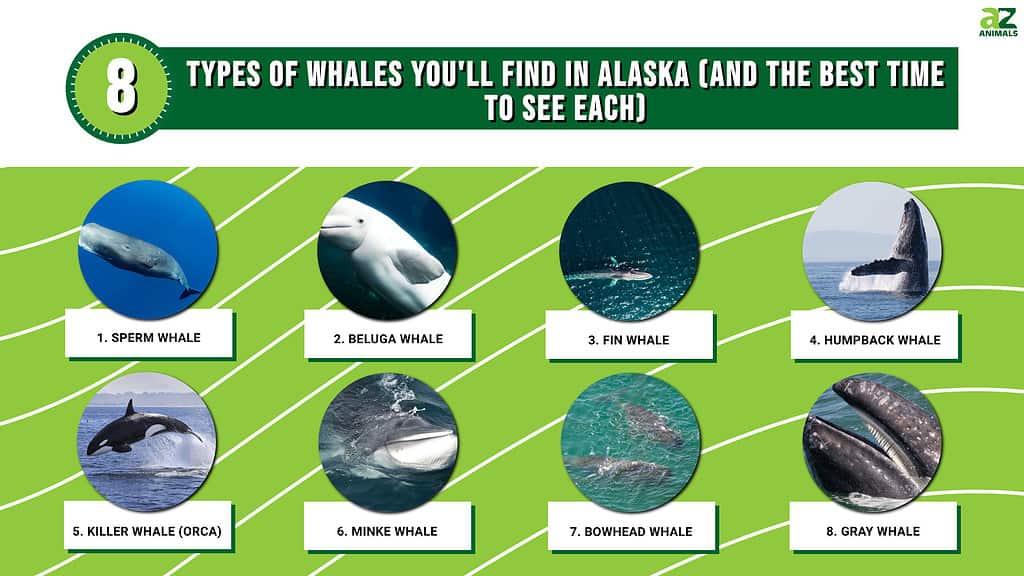
Alaska is well-known for its abundance of wildlife. Even though the climate may be harsh and the daylight hours are strange, the animals found here are nothing short of amazing. Whale-watching is incredibly popular in this state, and there are many opportunities here to see these incredible marine mammals. Whether they are just passing through on their annual migration or they call Alaskan waters home, various whales, both big and small, can be found in these waters. Here are 8 whales that you can find in Alaska and the best time to see them.
1. Sperm Whale (Physeter macrocephalus)

The largest-toothed predator in the world is the sperm whale.
©Animalgraphy/Shutterstock.com
The sperm whale, also known as the cachalot, is the largest toothed predator found worldwide. They are huge mammals, with males reaching around 52 feet long and an average weight of 45 tons. On the other hand, females are generally 40 feet long and weigh 15 tons. The sperm whale has a very large, block-shaped head, which can be up to one-third of the whale’s total length.
Interestingly, the brain of this incredible animal is the largest brain found on earth! Furthermore, the blowhole of the sperm whale is s-shaped, located at the front of the head, and skewed towards the left side. The flukes (or the two lobes of the whale’s tail) of this whale are very thick and triangular in shape.
Sperm whales are carnivores and will target larger species. Their diet consists of sharks, rays, squid, and fish. These gigantic creatures can eat between 3 and 3.5 percent of their body weight daily. Because sperm whales are so large, they do not have any true predators. The biggest threat to the sperm whale is humans.
Sperm whales are found in all of the world’s oceans, meaning you will find these amazing animals in Alaska as well. In Alaska, you can find sperm whales around the Gulf of Alaska, the Bering Sea, and surrounding islands. You can technically spot these whales year-round, but the best time to see them is during the summer months from May through September.
2. Beluga Whale (Delphinapterus leucas)
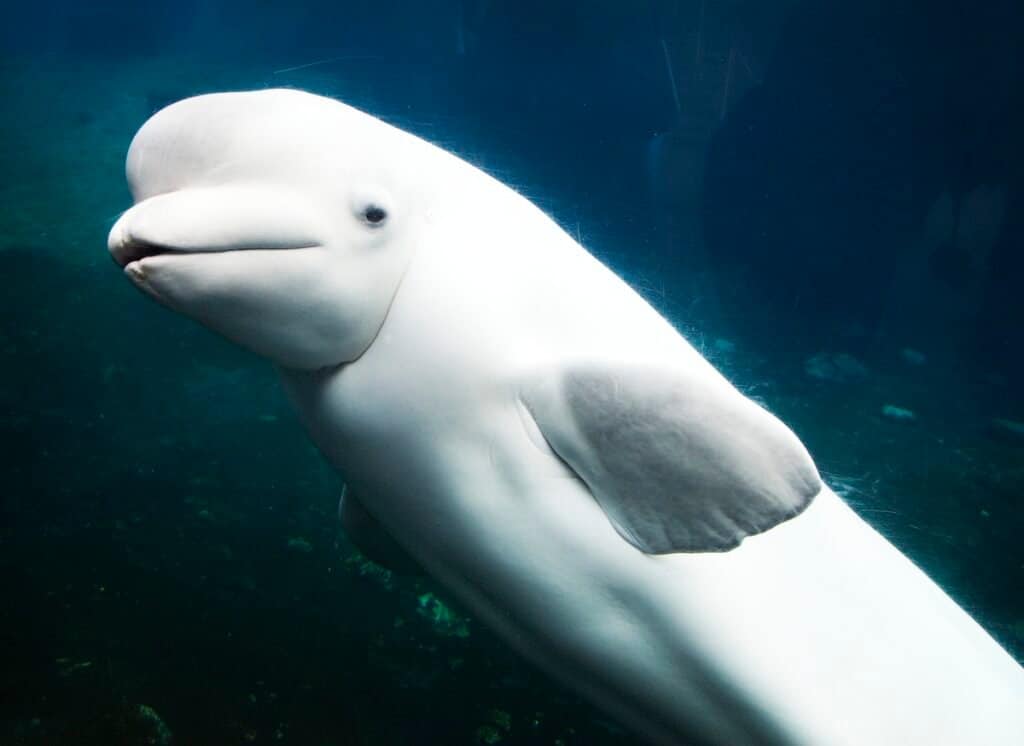
Unfortunately, since beluga whales are critically endangered, the chances of spotting them in Alaska are low.
©Carol M Highsmith / CC0 1.0, Rawpixel – License
Beluga whales are also known as white whales, sea canaries, and melonheads. Beluga whales have a very unique appearance. They are white in color, have a bulbous forehead, and don’t have a dorsal fin. The beluga is larger than a dolphin in size, yet smaller than a true whale. They can measure up to 11-15 feet long and weigh up to 3,300 pounds.
Beluga whales are well suited to arctic waters, with the majority of their body weight being insulating blubber. The large bulge on their foreheads allows them to produce high-pitch noises that they use for echolocation, which helps them to locate breathing holes, hunt prey, and communicate as they travel under the ice. Belugas are opportunistic feeders. They eat a varied diet consisting of fish, octopus, sandworms, shrimp, and crabs, among other sea animals.
In Alaska, for the best chance of spotting beluga whales, try your luck at the Cook Inlet, Bristol Bay, the eastern Bering Sea, the eastern Chukchi Sea, and the Beaufort Sea. Unfortunately, beluga whales are considered critically endangered, so you would have to be incredibly lucky to spot one.
3. Fin Whale (Balaenoptera physalus)
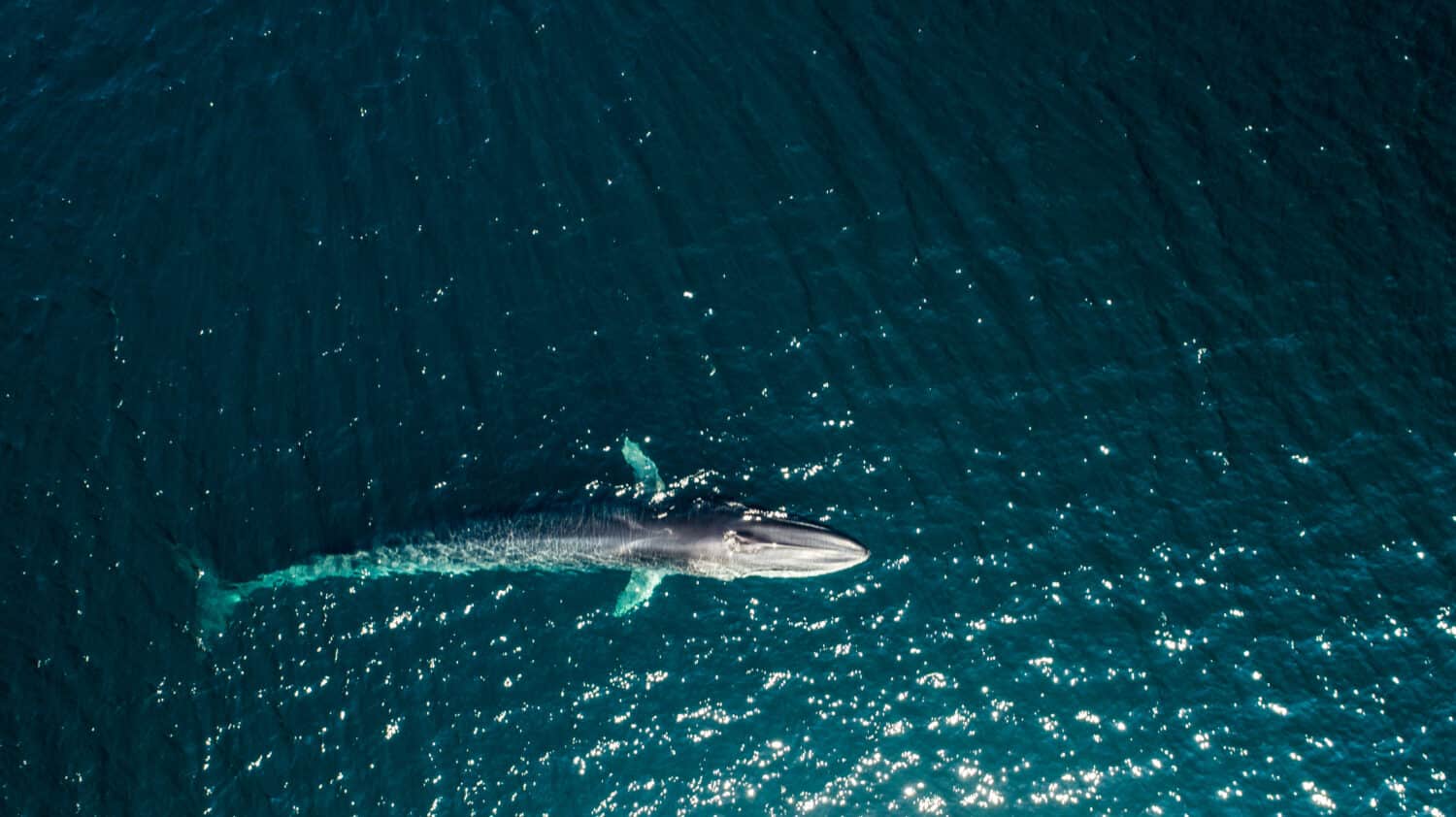
You can find fin whales in Alaska in the summer.
©Leonardo Gonzalez/Shutterstock.com
Fin whales have long and sleek bodies with smooth skin. They have a light underside and light grey upper body. These whales grow up to 79 feet long and 75 tons heavy, coming in only behind the blue whale in terms of size. Instead of teeth, the fin whale has baleen plates to catch its prey and 55 to 100 ventral grooves on their throat. This allows the mouth to expand to huge sizes when feeding.
The diet of the fin whale includes small fish and invertebrates. They use their large mouths to gulp up their prey and swim on their sides when they feed. This whale is migratory and will travel great distances for food or breeding opportunities. They usually travel in pods of around 6 to 10 individual whales, but they can occasionally be found alone or in pairs as well.
Fin whales migrate to colder northern waters during spring and early summer for feeding, and travel back to warmer, more southern waters in fall for breeding during winter.
To see these whales in Alaska, the best time would be the summer months between July and September. For a chance to see them, you’ll need to travel to deeper waters.
4. Humpback Whale (Megaptera novaeangliae)
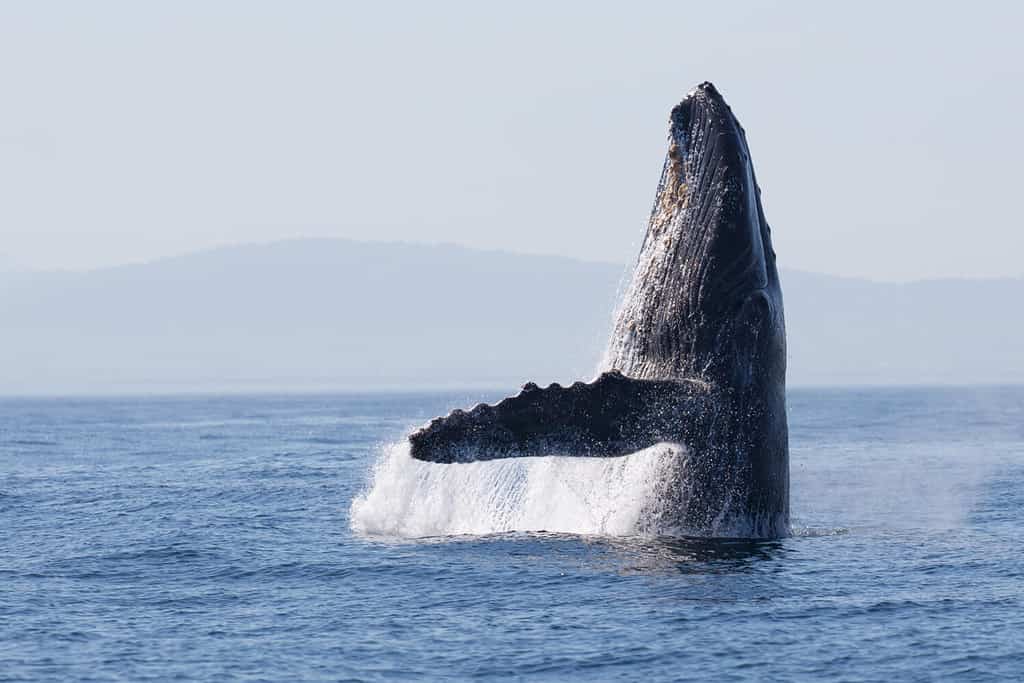
The best time to spot the humpback whale is in the summer.
©Tory Kallman/Shutterstock.com
The humpback whale is a whale with a distinguishable hump near the dorsal fin, hence its name. This animal also has hair follicles over the head and the jaw. Instead of teeth, humpback whales have baleen plates that filter out their food. These whales generally have a dark back with a lighter underside. In terms of size, the adult humpback whale can grow to 60 feet long. Female humpback whales are generally longer than males, which is unusual for a mammal. The weight of an adult humpback whale is around 40 tons.
The humpback whale can be found anywhere in the world, including Alaska. They live and feed near the shore of oceans and seas and can swim very close to land. This species incredibly undertakes an epic migration and can swim up to 16,000 miles a year!
The diet of this mighty whale consists of plankton, fish, and crustaceans. Due to their monstrous size, adult humpback whales have very few natural predators. However, sharks and killer whales are known to kill and attack this species.
Humpback whales can be found in Southeast Alaska, the Barren Islands, the Aleutian Islands, Kodiak, and Prince William Sound in the summer months. The best time to see these magnificent whales is in June and July.
5. Killer Whale (Orca) (Orcinus orca)
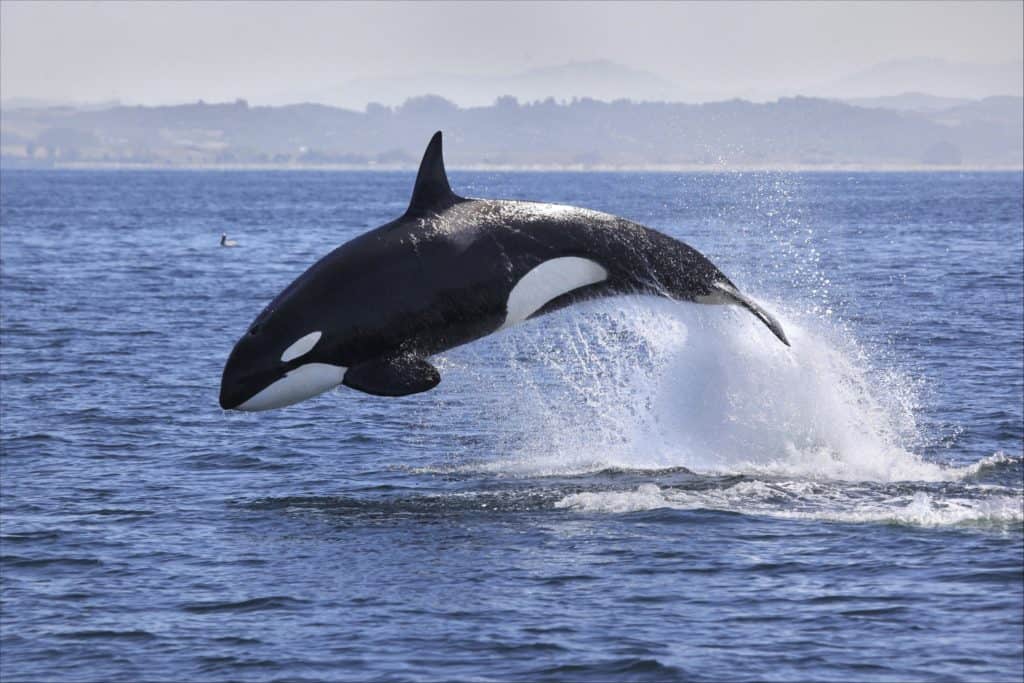
Also called orcas, killer whales are technically dolphins.
©Tory Kallman/Shutterstock.com
Killer whales are toothed whales that technically belong to the dolphin family, but they’re worth mentioning on this list anyway – thanks to their sheer size! The killer whale has a beautiful smooth black back with a large dorsal fin. The underside of the killer whale is bright white. These creatures also have a white eyespot just behind each of their eyes, and their teeth can grow up to 4 inches long! On average, males are between 20 and 26 feet long and weigh around 6 tons. And Female orcas are around 16 to 23 feet long and weigh up to 5.5 tons.
The diet of the killer whale consists of meat as they are carnivores. They hunt with the use of echolocation. These incredible predators feed on fish, squid, seals, and even sea birds. Luckily for killer whales, they have no natural predators.
Killer whales are found in every ocean and most seas. These creatures can be found throughout the waters of Alaska. Although killer whales can be seen year-round in Alaska, the best time to see these mammals is during the summer. The best months to see them would be between April and November.
6. Minke Whale (Balaenoptera acutorostrata)

The second smallest
baleen whale
, the minke whale grows up to 35 feet long.
©Tim Watters/Shutterstock.com
The minke whale is a baleen whale and is the second smallest member of this family (the pygmy right whale is the smallest). The dorsal side of this whale is dark gray to black, while the underside is white. These whales also have a white band on their pectoral fins. Minke whales can measure up to 35 feet long, and they can weigh up to 10 tons. Interestingly, female minke whales are typically larger than males.
The diet of the minke whale consists of krill, herring, sand eels, and more. Unfortunately, the minke whale does have predators, with the greatest threat to this species being the killer whale.
The minke whale can be found around the world. Although they do prefer boreal water habitats, these whales can be found in tropical waters as well. In Alaska, minke whales can be found in the spring and summer. You can find them in Kachemak Bay, Glacier Bay, and Prince William Sound.
7. Bowhead Whale (Balaena mysticetus)
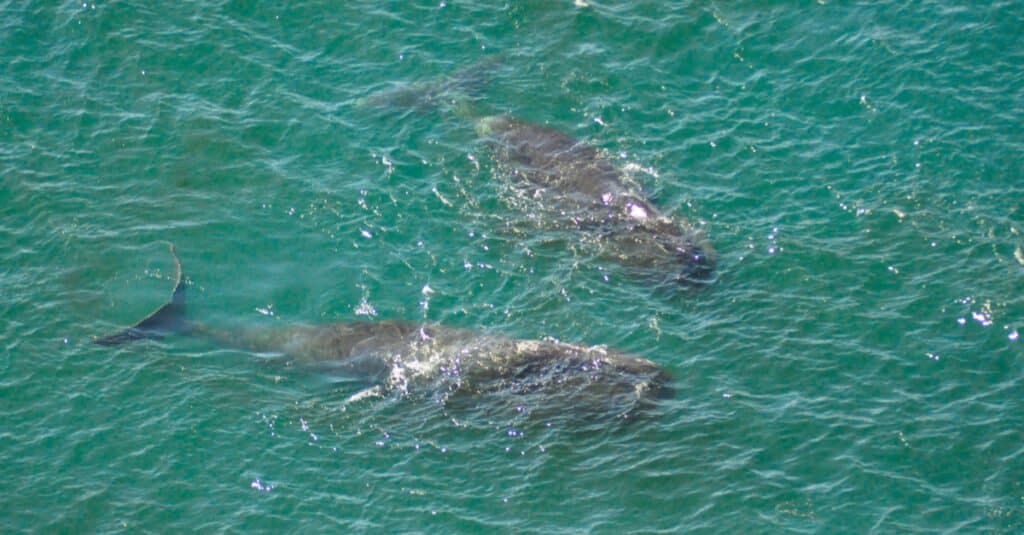
These whales can break through super thick ice.
©Vladimir Chebanov/Shutterstock.com
Bowhead whales are majestic sea creatures that are named for their triangular skulls. Their skull helps these whales to break through ice up to 24 inches thick! These whales are the most ice adapted of the large whales.
Bowhead whales are dark in color except for their chin and lower jaw, which are white. Unlike most whales, these creatures do not have dorsal fins. A fun fact about the bowhead whale is that it has the largest mouth in the entire animal kingdom. The bowhead whale’s mouth can measure up to 16 feet long, 12 feet high, and 8 feet wide! The whale’s baleen is also the longest of any whale and can reach a length of 10 feet. Bowhead whales also have two blowholes located at the tip of their head. These marine mammals can grow up to 60 feet long and weigh over 100 tons in some cases.
The bowhead whale’s diet consists of amphipods, crustaceans, and zooplankton. This whale eats around 2 tons of food per day. Due to its sheer size, the bowhead whale does not have many natural predators. However, it is known that a pod of killer whales may sometimes prey on the bowhead whale.
Bowhead whales have the longest lifespan of any mammal, living over 200 years.
Bowhead whales live in the cold Arctic water and can be found near the sea ice in the Bering, Chukchi, and Beaufort Seas. The best time to see these whales is in the spring, between April and May.
8. Gray Whale (Eschrichtius robustus)
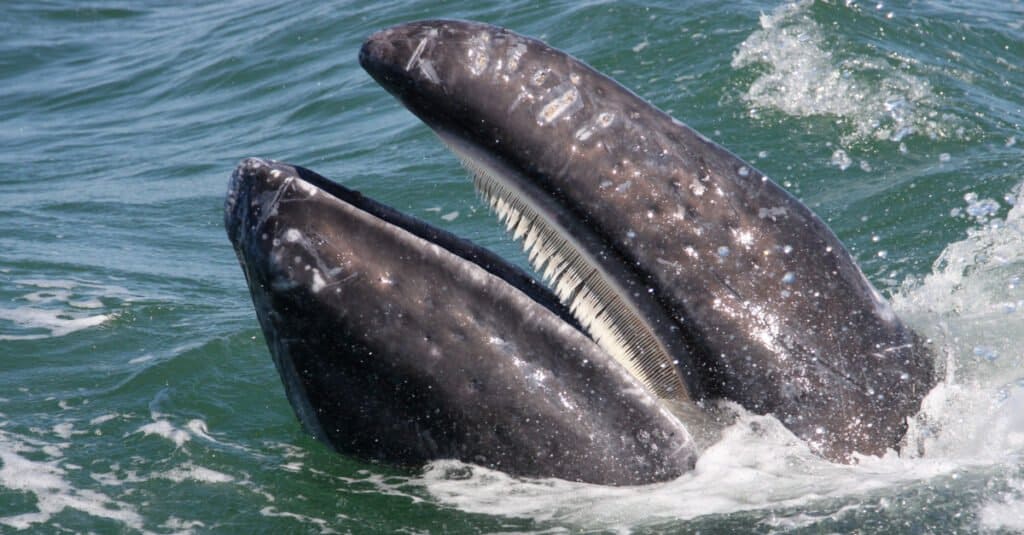
Traveling tens of thousands of miles every year, gray whales can be spotted in Alaska in the spring and fall.
©jo Crebbin/Shutterstock.com
The gray whale is a baleen whale that gets its name from the gray patches and white mottling on the dark slate-colored skin. Adult gray whales measure between 43 and 49 feet in length and can weigh around 45 tons. These whales also have some protrusions running down their back. They also have two blow holes which can create a heart-shaped blow when they surface.
Gray whales feed by skimming their mouths across the sea bed, scooping up the ground-dwelling critters in their path, including sea animals such as crabs, worms, amphipods, and shrimp. The gray whale calls the waters of the North Pacific and North Atlantic ocean homes, including the waters of Alaska.
Gray whales hold the record of the farthest migration of any mammal and will travel tens of thousands of miles each year. They can be seen in Alaska during their yearly migration, and they pass through Alaskan waters twice annually. You may have a chance to spot them from March to June when these whales can be seen traveling toward the Arctic to feed, and again from the middle of October to early December as they head back to their breeding grounds around Mexico.
Summary of 8 Types of Whales You’ll Find in Alaska
| Whale | Scientific Name | Best Time to See in Alaska | |
|---|---|---|---|
| 1 | Sperm Whale | Physeter macrocephalus | Summer |
| 2 | Beluga Whale | Delphinapterus leucas | Year-round |
| 3 | Fin Whale | Balaenoptera physalus | Summer |
| 4 | Humpback Whale | Megaptera novaeangliae | Early summer |
| 5 | Killer Whale (Orca) | Orcinus orca | Mid-spring to end of fall |
| 6 | Minke Whale | Balaenoptera acutorostrata | Summer |
| 7 | Bowhead Whale | Balaena mysticetus | Spring |
| 8 | Gray Whale | Eschrichtius robustus | Spring and end of fall |
The photo featured at the top of this post is © Tory Kallman/Shutterstock.com
Thank you for reading! Have some feedback for us? Contact the AZ Animals editorial team.






